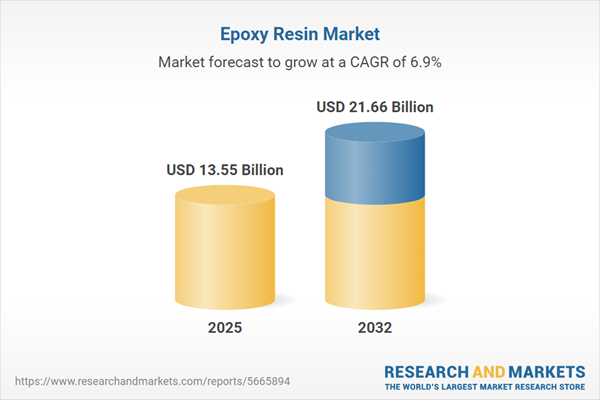Speak directly to the analyst to clarify any post sales queries you may have.
The epoxy resin market is experiencing pivotal transformation, shaped by innovation, regulatory shifts, and evolving customer needs across diverse global sectors. Senior executives require detailed, actionable insights to guide strategic decisions in this dynamic industry landscape.
Epoxy Resin Market Snapshot
The epoxy resin market grew from USD 12.65 billion in 2024 to USD 13.55 billion in 2025. With a projected CAGR of 6.94%, it is expected to reach USD 21.66 billion by 2032. The market’s expansion is driven by sustained demand in adhesives, coatings, and composites, growing preference for high-performance materials, and increased focus on sustainability. Advanced thermosetting polymers are enabling greater resilience and versatility, positioning the epoxy resin market for continued advancement.
Scope & Segmentation
The report provides in-depth analysis across the following critical segments and regions, reflecting the diversity of applications and geographical dynamics:
- Resin Types: Aliphatic, Bisphenol A, Bisphenol F, Novolac
- Forms: Liquid, Powder, Solid
- Applications: Non-structural Adhesives, Structural Adhesives, Decorative Coatings, Protective Coatings, Fiber-reinforced Composites, Particle-reinforced Composites
- End-User Industries: Aerospace, Automotive & Transportation, Construction, Electrical & Electronics, Marine, Wind Energy
- Distribution Channels: Direct Sales, Distributors/Suppliers, Online
- Regions: Americas (United States, Canada, Mexico, Brazil, Argentina, Chile, Colombia, Peru), Europe, Middle East & Africa (United Kingdom, Germany, France, Russia, Italy, Spain, Netherlands, Sweden, Poland, Switzerland, United Arab Emirates, Saudi Arabia, Qatar, Turkey, Israel, South Africa, Nigeria, Egypt, Kenya), Asia-Pacific (China, India, Japan, Australia, South Korea, Indonesia, Thailand, Malaysia, Singapore, Taiwan)
- Market Participants: Including 3M Company, Aditya Birla Group, ALTANA AG, Chemax Orhanochem Pvt. Ltd., China Petrochemical Corporation, Covestro AG, Daicel Corporation, DIC Corporation, Dow Inc, DuPont de Nemours, Inc., Henkel AG & Co. KGaA, Huntsman International LLC, INEOS AG, K2P Chemicals, Kolon Industries, Inc., Kukdo Chemical Co., Ltd, Mapei Spa, Merck KGaA, Mitsubishi Chemical Group Corporation, Mitsui Chemicals, Inc., Olin Corporation, Parker-Hannifin Corporation, Shiv Shakti Group, Sumitomo Bakelite Co., Ltd., and Sika AG
Key Takeaways for Decision-Makers
- Sustainability mandates, bio-based innovations, and low-emission solutions are shaping procurement and R&D priorities for industry leaders.
- Investment in digital manufacturing, automation, and predictive analytics is accelerating time-to-market, enabling rapid adaptation to client-specific requirements.
- Supply chain resilience is improving through nearshoring, flexible sourcing, and collaborative risk management, important in today’s regulatory climate.
- Strategic collaborations are fostering the development of advanced composite materials, addressing lightweighting and lifecycle credentials in key sectors.
- Circular economy initiatives, such as chemical recycling and refurbishment, are gaining traction, gradually positioning industry frontrunners to benefit from environmental regulations.
Tariff Impact and Supply Chain Adaptation
Recent United States tariffs on essential epoxy resin intermediates have compelled many manufacturers to restructure procurement strategies, emphasizing domestic and regional supplier partnerships. As a result, supply chain architectures are evolving to minimize exposure to tariff volatility and ensure continuity of critical raw materials. These developments are forcing companies to intensify supplier risk assessments and enhance transparency within their networks. The trend toward nearshoring and regional logistics is enabling more efficient and controlled feedstock management while supporting cost optimization efforts across coatings, adhesives, and composites value chains.
Research Methodology & Data Sources
The report synthesizes primary interviews with senior executives at leading epoxy resin producers and end-users, complemented by secondary research from academic literature, regulatory filings, and industry white papers. Quantitative modeling, sensitivity analyses, and outlier checks ensure integrity. Regional segmentation and application data are benchmarked against global trade flows for enhanced reliability.
Why This Report Matters
- Helps senior leaders align R&D, supply chain, and commercial strategies with evolving segment and regional realities in the epoxy resin market.
- Delivers actionable intelligence to anticipate and address regulatory, tariff-related, and sustainability-driven market disruptions.
- Enables strategic partnerships by outlining innovation drivers and detailed competitive profiling across all major geographies and end-user segments.
Conclusion
This report is designed to equip decision-makers with strategic clarity and direction in a rapidly evolving epoxy resin sector. Leverage its data-driven insights to accelerate innovation, manage risk, and capture growth opportunities across global markets.
Additional Product Information:
- Purchase of this report includes 1 year online access with quarterly updates.
- This report can be updated on request. Please contact our Customer Experience team using the Ask a Question widget on our website.
Table of Contents
3. Executive Summary
4. Market Overview
7. Cumulative Impact of Artificial Intelligence 2025
Companies Mentioned
The companies profiled in this Epoxy Resin market report include:- 3M Company
- Aditya Birla Group
- ALTANA AG
- Chemax Orhanochem Pvt. Ltd.
- China Petrochemical Corporation
- Covestro AG
- Daicel Corporation
- DIC Corporation
- Dow Inc
- DuPont de Nemours, Inc.
- Henkel AG & Co. KGaA
- Huntsman International LLC
- INEOS AG
- K2P Chemicals
- Kolon Industries, Inc.
- Kukdo Chemical Co., Ltd
- Mapei Spa
- Merck KGaA
- Mitsubishi Chemical Group Corporation
- Mitsui Chemicals, Inc.
- Olin Corporation
- Parker-Hannifin Corporation
- Shiv Shakti Group
- Sumitomo Bakelite Co., Ltd.
- Sika AG
Table Information
| Report Attribute | Details |
|---|---|
| No. of Pages | 180 |
| Published | November 2025 |
| Forecast Period | 2025 - 2032 |
| Estimated Market Value ( USD | $ 13.55 Billion |
| Forecasted Market Value ( USD | $ 21.66 Billion |
| Compound Annual Growth Rate | 6.9% |
| Regions Covered | Global |
| No. of Companies Mentioned | 26 |









